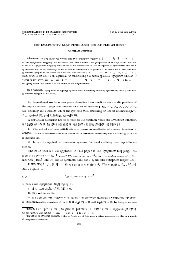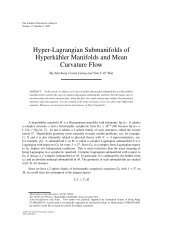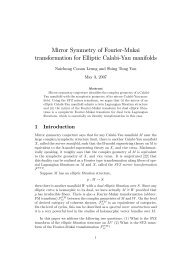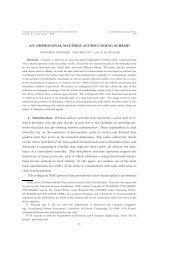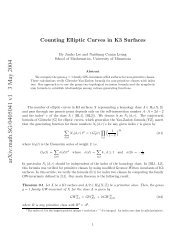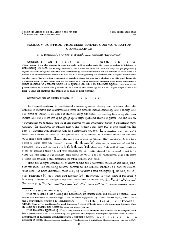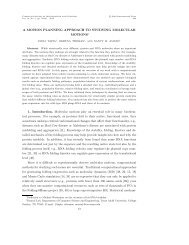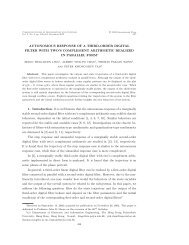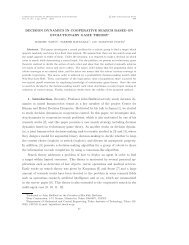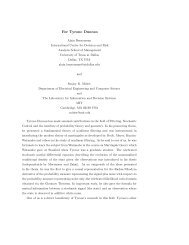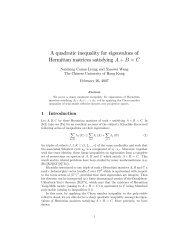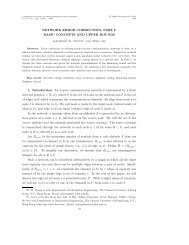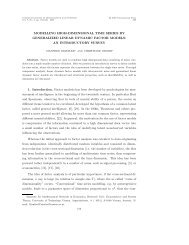AN OPTIMAL DISTRIBUTED ROUTING ALGORITHM USING DUAL ...
AN OPTIMAL DISTRIBUTED ROUTING ALGORITHM USING DUAL ...
AN OPTIMAL DISTRIBUTED ROUTING ALGORITHM USING DUAL ...
You also want an ePaper? Increase the reach of your titles
YUMPU automatically turns print PDFs into web optimized ePapers that Google loves.
290 PUNYASLOK PURKAYASTHA <strong>AN</strong>D JOHN S. BARAS<br />
r<br />
Source S<br />
F<br />
1<br />
F<br />
N<br />
Capacity C<br />
.<br />
.<br />
.<br />
1<br />
Capacity C N<br />
Destination D<br />
Fig. 2. The N parallel paths network<br />
We denote this (unique) solution by F ∗ (β) = (F1 ∗(β), . . . , F N ∗ (β)), emphasizing its<br />
dependence on β.<br />
Suppose now that C 1 > C 2 = · · · = C N . Then using the relations<br />
one can check that<br />
and consequently that<br />
F ∗ 1 (β)[D(F ∗ 1 (β), C 1)] β = · · · = F ∗ N (β)[D(F ∗ N (β), C N)] β ,<br />
F ∗ 1 (β) > F ∗ 2 (β) = · · · = F ∗ N (β)<br />
(21) D(F ∗ 1 (β), C 1 ) < D(F ∗ 2 (β), C 2 )(= · · · = D(F ∗ N(β), C N )).<br />
In this subsection, lets assume that β is a nonnegative real number (instead of<br />
being a positive integer). To arrive at a contradiction, lets suppose, for some small<br />
positive δβ that F ∗ 1 (β + δβ) < F ∗ 1 (β); then we also have F ∗ 2 (β + δβ) > F ∗ 2 (β). This<br />
implies that<br />
(22)<br />
F1 ∗ (β + δβ)<br />
F2 ∗(β + δβ) < F 1 ∗(β)<br />
F2 ∗(β).<br />
Using the relationships with the delays, we then have<br />
[ D(F<br />
∗<br />
2 (β + δβ), C 2 )<br />
D(F ∗ 2 (β), C 2)<br />
[ D(F<br />
∗ ]β+δβ<br />
2 (β + δβ), C 2 )<br />
D(F1 ∗(β + δβ), C <<br />
1)<br />
D(F1 ∗ .<br />
(β), C 1)<br />
D(F1 ∗(β + δβ), C 1)<br />
]β+δβ<br />
<<br />
[ D(F<br />
∗ ]β<br />
2 (β), C 2 )<br />
D(F1 ∗(β), C ,<br />
1)<br />
[ D(F<br />
∗ ]δβ<br />
1 (β), C 1 )<br />
D(F2 ∗(β), C .<br />
2)<br />
Using the hypothesis and the monotonicity property of the delay function with<br />
respect to the flow, it is easy to see that the left hand side of the above inequality is<br />
greater than one, which implies that<br />
D(F ∗ 1 (β), C 1) > D(F ∗ 2 (β), C 2),




